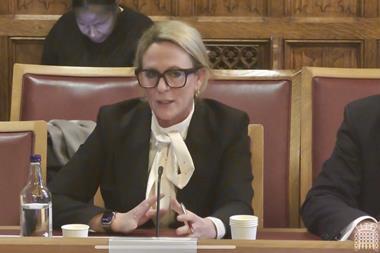The final part of our series examining the challenges facing insurance companies looks at the pressure on insurers to cut costs.
A wave of job cuts is set to hit the insurance industry as insurers begin a process of cost-cutting and restructuring. Last week insurance giants Norwich Union and Zurich announced that between them as many as 2,700 jobs could be lost as the companies reorganised their businesses.
Norwich Union (NU) said that up to 1,800 redundancies were expected in the next two years as the company looked to streamline its business, scaling back its sprawling regional office structure and hefty product range, and simplifying its systems and processes.
Igal Mayer, NU Insurance chief executive, said the changes were necessary to improve the efficiency of the business and deliver the service customers wanted.
Zurich said between 700 and 900 – as much as one sixth of its UK workforce – would go as the company looked to slash 10% from its cost base. Its chief executive Guy Munnoch said the business needed to become more efficient to take advantage of a future upturn in the market.
“If we want to remain competitive, we must act swiftly to increase efficiencies,” he said, adding that all options were being considered including further offshoring and reducing the number of regional offices.
And experts warn that the cost-cutting is unlikely to end with NU and Zurich. Tony Hulse, a partner and head of general insurance at KPMG, says: “Reducing cost is a major driver for every business. When it is difficult to grow, you need to look at costs. Many companies are looking at retrenchment,” he says.
The tough conditions in the insurance market are seen as one of the key drivers for this wave of restructuring. A protracted period of softening rates coupled with ever rising claims costs have been eating into insurers’ margins and making growth difficult.
Moreover, recent years have seen insurers release billions of pounds in prior year reserves to shore up their profits, which many argue is unsustainable. In 2007, UK motor insurers alone released nearly a billion pounds in prior year reserves. There have been warnings from the likes of Allianz Insurance chief executive Andrew Torrance that insurers’ reserves will soon run dry.
Mark Winlow, a director of consultancy firm LECG and former head of personal lines at Zurich UK, says: “The market cycle is a big factor in driving this cost cutting. If insurers can’t raise income, they will look to cut costs.
“UK insurers have built up reserves and have been releasing them. But they won’t be able to do that anymore, so the only way to make a profit is to cut costs.”
Andrew Power, insurance partner at Deloitte, says the commoditisation of products, particularly in the personal line sector, is forcing insurers to reduce their costs.
“Increased commoditisation, particularly in personal lines, is making cost a key element. It is difficult to differentiate other than on price, so there is intensive focus on cost and that is why we have seen some of the actions by the insurers.”
These cost pressures have been heightened by the growth of direct sales and the emergence of aggregators, both of which have served to increase the price competition in the market, he says.
“I would be surprised if other insurers are not looking at similar levels of cost reduction.
Tony Hulse, KPMG
Winlow says UK insurers that are part of global groups could be under greater pressure. He says global businesses have high head office costs, which are inflexible, such as accountants and corporate finance specialists. “It is easier to cut costs lower down the tree, at a local level.”
He notes that both Zurich and NU are part of global operations. “The UK operation is a significant part of the business of each.”
Winlow also suggests that rising costs from intermediary distribution could play a factor and add to the pressure to reduce expenses.
Insurers such as NU and AXA have been vocal about the high commission levels paid to brokers, particularly the powerful consolidators. NU has been actively looking to grow its accounts with smaller brokers which by definition are less demanding in terms of commissions.
KPMG’s Hulse says that legacy issues arising from previous acquisition activity and growth initiatives are a factor for insurers. Many insurers have complex and unwieldy structures involving multiple underwriting platforms and service companies, which lead to inefficiencies.
Indeed, NU says that part of the rationale for its restructure is to slim down the cumbersome operation that has emerged from previous mergers and acquisition activity.
Views differ as to the extent these cost pressures will be felt by other insurers. Hulse says other insurers will be under similar pressure as Zurich and NU. “They are responding to the environment. I would be surprised if other insurers aren’t looking at similar levels of cost reduction,” he says.
Hulse argues that the redundancies of the order announced by NU and Zurich – up to 10% of the UK workforce in NU’s case – could be mirrored by other insurers.
“[Staff cuts at] NU and Zurich have got to be representative of the approach that will be adopted by other insurers. Staff costs make up 50% of operational costs,” says Hulse. But he adds: “There is not one route that is appropriate for everyone.”
Deloitte’s Power is cautious in his assessment of the extent to which other insurers will look to slash costs. “Other companies start from different points. For instance, are they in price competitive sectors?” he says.
But he adds every company will need to address their fundamentals: “They need to increase productivity and lower costs.”
Winlow at LECG says the scale of other companies’ cost reductions will not be the same as that being sought by NU and Zurich.
Reducing costs does not necessarily lead to redundancies. Winlow points to the potential for savings from the sale and leaseback of premises, or the changing of employee benefits such as pensions.
How major insurers are streamlining their businesses
Norwich Union (NU) is looking to transform the operations part of the business, which includes its back office, claims and customer service functions. Following mergers and acquisitions, this part of the business has become too complex with too many products, process, systems and locations. The insurer also says it needs to adapt to consumers changing buying habits, such as greater use of the internet.
Over the next two years, NU will create seven sites for its operations function,
withdrawing from 13 sites. It will also reduce the number of roles by between 1,500 and 1,800 during that period.
NUs broker trading presence at 40 UK sites will not be affected.
Igal Mayer, NU Insurance chief executive, says: We want to deliver excellent, consistent and reliable customer service with market leading efficiency. To do this we need to fundamentally simplify our business.
Hosted by comedian and actor Tom Allen, 34 Gold, 23 Silver and 22 Bronze awards were handed out across an amazing 34 categories recognising brilliance and innovation right across the breadth of UK general insurance.













































